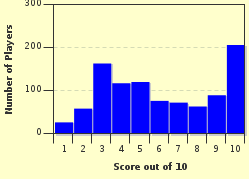Quiz Answer Key and Fun Facts
1. Aristaeus was the son of the Sun God Apollo and a huntress named Cyrene. Although a minor God in the Greek Pantheon, he is credited with playing a major part in the founding of the great city of Thebes, and also with introducing mortals to which useful process involving invertebrates?
2. The Kiowa Apache creation myth tells how strings were tugged to stretch and shape a ball of mud. The ball was pulled larger and larger and eventually became the Earth. The four strings were specific colours, black to the east, blue to the south, yellow to the west, and white to the north.
Which creature did the pulling of the strings and thus created Earth?
3. The Tongan creation myth tells us how a plover pecked a "fat juicy worm" (or maggot) into three pieces and these pieces fell to the ground and became the first humans.
Which of the following was NOT one of these three first people?
4. There are several legends in Greek mythology that tell us about the mighty warrior Orion. One of these tales tells us how Orion threatened to hunt and kill every animal on the Earth, and was only stopped when he was killed by an invertebrate. Both Orion and his spineless killer were then placed in the Heavens as constellations. Which constellation did the invertebrate in question become?
5. In the creation story of the Cherokee people, the land is formed amid an endless sea when Dayuni'si, the "little water beetle", brings up mud from the depths. Although he himself is a water beetle, Dayuni'si is also known as "Grandchild of _____"; whose grandchild is he?
6. In the creation myth of the Native American Haida people, the first men are released into the world when a bored raven frees them from a trap. What were they trapped in?
7. In the creation myth of the Lakota Native Americans, a spider trickster figure went down to the underworld and brought the first man, Tokahe, up through a cave and out onto the Earth. What name do the Lakota give to this tricky spider?
8. The Navajo creation myth begins with the small "Black World" floating in the mists. It is populated by Holy Ones, Coyote, and the insect people who will eventually become men and women after journeying through the "Blue World" and "Yellow World" to the "White World", which is our Earth.
The Navajo ancestral homeland on the White World has a name of its own; what is this name?
9. The Maori myths tell of the creation of insects by Hine-nui-te-po, who was an important Goddess, daughter of Tane the God of the Forests.
What was Hine-nui-te-po the Goddess of?
10. The Mayan/Guatemalan creation myth is told in the "Book of the Mat" which has come down through the ages orally, and was first written down around the year 1700 by one Father Ximenez, a Spanish monk.
One of the earliest things to be mentioned in the text are crabs (of all things!), and the book is widely known by which other name?
Source: Author
Rowena8482
This quiz was reviewed by FunTrivia editor
CellarDoor before going online.
Any errors found in FunTrivia content are routinely corrected through our feedback system.

